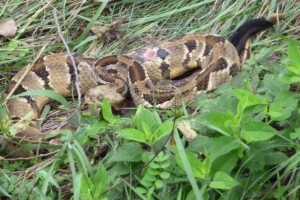A hiker recently hospitalized after a rattlesnake bite near Caledonia is a rare reminder that there really are rattlesnakes in most Mississippi River blufflands.
My experience with the snakes while hiking
is that they do NOT flee a hiker, but lie still in hopes that we will not see them. Generally, when we do see them, they are laying in the sun on, or at the side of, the hiking path. If we are lucky, they rattle — but only as a last resort. And not every snake will offer that warning.
My experience is that they blend into the background so completely they are almost impossible to see without a warning rattle. Coloration of a rattlesnake will vary from gray tones (when they live in limestone areas) to the normal tans and browns or yellows. But the triangular head, and the distinctly black tail with rattles are diagnostic.
I was hiking with a ranger in the bluffs in Missouri on one occasion and he leaned over to pick up a bit of litter… “Oh, shoot,” he said quietly, and slowly pulled away his outstretched arm. The “litter” was in fact a coiled, nearly gray and white rattlesnake. It did not offer a rattle.
So if you are hiking in the bluffs, stay alert.








 We’re close to hitting 50 degrees in the Upper Mississippi River Valley. Sandhill cranes, Canada Geese, starlings have all returned. The Mourning Dove is cooing again and the morning is beginning to be vibrant with bird chatter. We’ve heard from the St. Louis area that pelicans are back on their way north. I don’t know that ANYONE appreciates spring like someone who lives up here!
We’re close to hitting 50 degrees in the Upper Mississippi River Valley. Sandhill cranes, Canada Geese, starlings have all returned. The Mourning Dove is cooing again and the morning is beginning to be vibrant with bird chatter. We’ve heard from the St. Louis area that pelicans are back on their way north. I don’t know that ANYONE appreciates spring like someone who lives up here!


